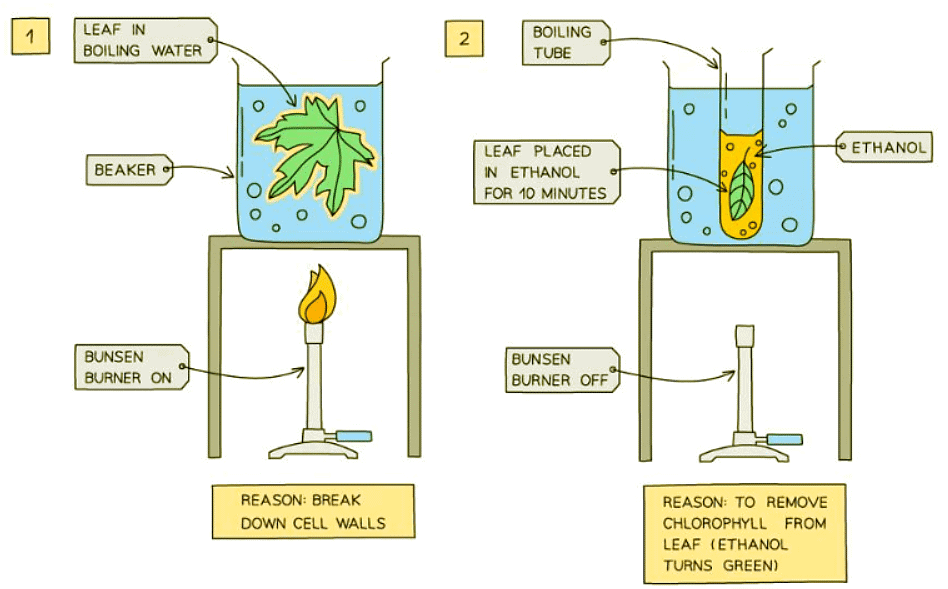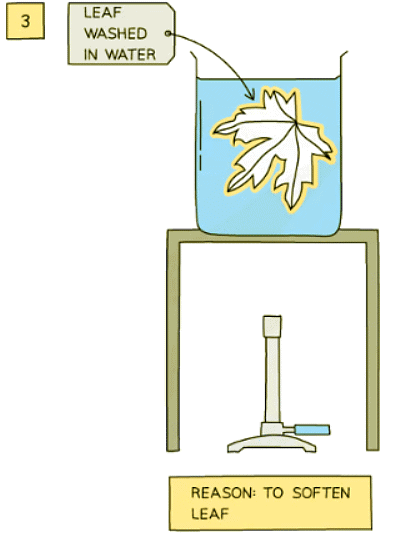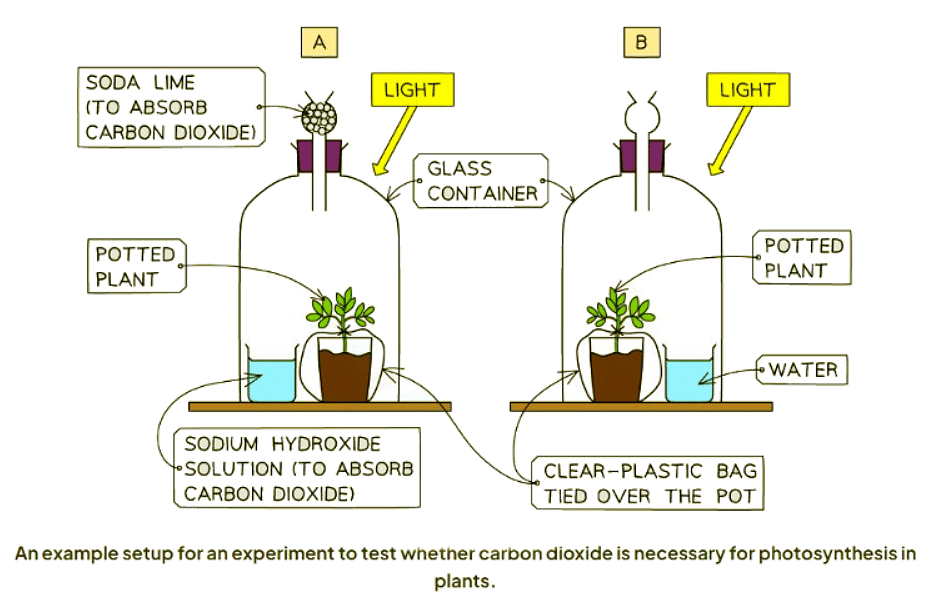Class 10 Exam > Class 10 Notes > Biology for GCSE/IGCSE > Need for Chlorophyll, Light & Carbon Dioxide
Need for Chlorophyll, Light & Carbon Dioxide | Biology for GCSE/IGCSE - Class 10 PDF Download
Investigating the Need for Chlorophyll
- Plants produce glucose through photosynthesis, but it's challenging to detect glucose in leaves due to its rapid utilization, conversion into other compounds, or storage as starch.
- Starch is stored in chloroplasts, the sites of photosynthesis, making testing for starch a reliable method to identify regions of active photosynthesis in a leaf.
- Procedure for testing leaves for starch:
- A leaf is immersed in boiling water to terminate cell activity and facilitate cell membrane breakdown.
- The leaf is then placed in hot ethanol for 5-10 minutes in a boiling tube to eliminate chlorophyll, enhancing visibility of color changes from iodine.
- Subsequently, the leaf is softened by dipping it in boiling water before being spread on a white tile and covered with iodine solution.
- In a green leaf, the entire leaf turns blue-black, indicating active photosynthesis across all leaf areas.
- Using a variegated leaf (partially green and partially white) allows testing to determine the necessity of chlorophyll for photosynthesis.
- The absence of chlorophyll in white leaf areas results in orange-brown coloration, demonstrating the lack of photosynthesis and starch storage in those regions.



- Care must be taken during the experiment with ethanol due to its high flammability. Ensure the Bunsen burner is turned off at the required stage to prevent accidents.
- It is safest to heat ethanol using an electric water bath rather than a beaker over an open flame from a Bunsen burner.
Investigating the Importance of Light in Photosynthesis
- When exploring the necessity of light for photosynthesis, a standard procedure involves initially destarching a plant by storing it in darkness for 24 hours.
- This destarching step ensures that any existing starch in the leaves is depleted, preventing it from influencing the experiment's outcomes.
- Following destarching, a leaf from the plant can be partially shielded with aluminum foil and exposed to sunlight for a day.
- After exposure, the leaf is removed and tested for starch using iodine solution.
- Areas of the leaf covered by foil retain an orange-brown color, indicating the absence of sunlight and thus no photosynthesis, while sun-exposed regions turn blue-black.
- This observation confirms that light is a critical factor for photosynthesis and the formation of starch.
Question for Need for Chlorophyll, Light & Carbon DioxideTry yourself: What is the purpose of immersing a leaf in boiling water during the procedure for testing leaves for starch?View Solution
Investigating the Importance of Carbon Dioxide in Photosynthesis
- Prepare two plants for the experiment by keeping them in the dark for an extended period to remove any stored starch.
- Place one plant in a bell jar along with a beaker of sodium hydroxide, which absorbs carbon dioxide from the air.
- Keep the other plant in a bell jar with a beaker of water as a control setup, where carbon dioxide absorption does not occur.
- Expose both plants to bright light for several hours to initiate photosynthesis.
- After the light exposure, test both plants for starch presence using iodine solution.
- The leaf from the plant near the sodium hydroxide will maintain an orange-brown color, indicating the inability to photosynthesize due to the lack of carbon dioxide.
- The leaf from the plant near water should turn blue-black, signifying that it had all the necessary components for successful photosynthesis.

The document Need for Chlorophyll, Light & Carbon Dioxide | Biology for GCSE/IGCSE - Class 10 is a part of the Class 10 Course Biology for GCSE/IGCSE.
All you need of Class 10 at this link: Class 10
|
101 videos|193 docs|33 tests
|
FAQs on Need for Chlorophyll, Light & Carbon Dioxide - Biology for GCSE/IGCSE - Class 10
| 1. Why is chlorophyll important for photosynthesis? |  |
Ans. Chlorophyll is a pigment found in the chloroplasts of plant cells that absorbs light energy. This light energy is essential for converting carbon dioxide and water into glucose during photosynthesis, making chlorophyll crucial for the process.
| 2. How does light affect photosynthesis? |  |
Ans. Light is a key factor in photosynthesis as it provides the energy needed to drive the chemical reactions that convert carbon dioxide and water into glucose. Without light, plants would not be able to produce their own food.
| 3. Why is carbon dioxide necessary for photosynthesis? |  |
Ans. Carbon dioxide is a reactant in the process of photosynthesis. It is absorbed by plants through tiny openings called stomata and, along with water and light energy, is used to produce glucose and oxygen. Without carbon dioxide, photosynthesis cannot occur.
| 4. What would happen if plants did not have chlorophyll? |  |
Ans. Without chlorophyll, plants would not be able to absorb light energy needed for photosynthesis. As a result, they would not be able to produce glucose and oxygen, which are essential for their growth and survival.
| 5. How does the absence of light impact the rate of photosynthesis? |  |
Ans. The absence of light significantly reduces the rate of photosynthesis as plants are unable to obtain the necessary energy to drive the process. Without light, the production of glucose and oxygen is halted, leading to a decrease in plant growth and overall health.
Related Searches




















